Sturdy hedges create effective windbreaks in snowy regions by reducing wind speed up to 85% and lowering heating costs by 30%. You’ll want evergreens for year-round protection with deciduous varieties mixed in for sunlight penetration. Aim for 6-8 foot heights with 50-65% density for ideal snow control. Plant in staggered rows, spacing shrubs 3-6 feet apart and conifers 20-25 feet apart. Discover how these natural barriers can transform your winter landscape and support local wildlife.
The Science of Wind and Snow Control With Hedges
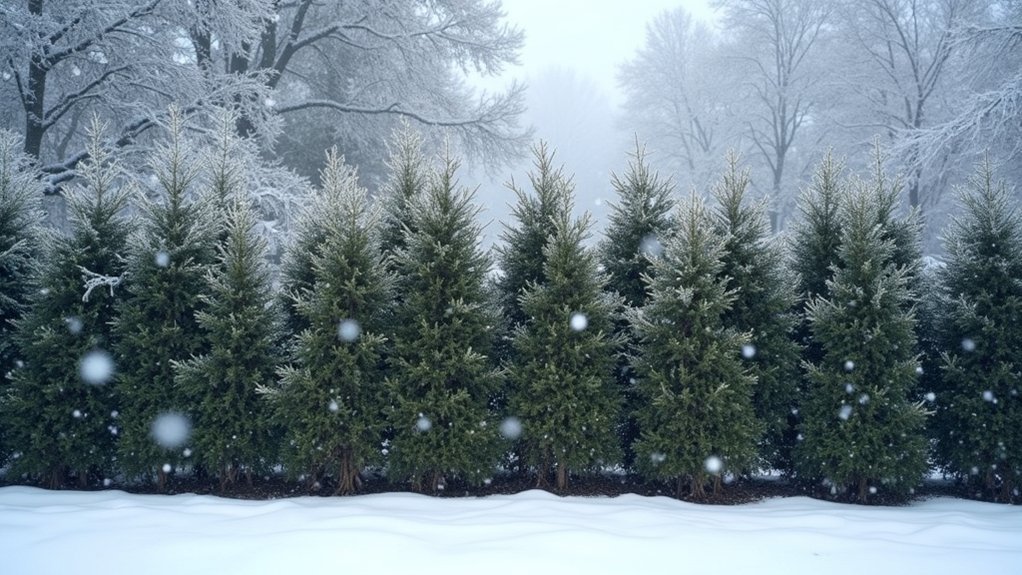
When winter winds howl across open landscapes, they carry snow that can drift into problematic areas around your property. A well-designed privacy hedge can reduce this wind speed by up to 50%, considerably decreasing snow accumulation where it’s unwanted.
For ideal snow control, aim for hedges with 50-65% density. This porosity allows some wind to filter through while blocking enough to prevent drifting. The most effective arrangement combines twin rows of deciduous shrubs with evergreen trees, creating a barrier that works year-round.
Your dense hedge doesn’t just control snow—it can reduce your heating costs by shielding buildings from harsh winter winds.
Choose native, winter-hardy plants that can withstand heavy snow loads without breaking, ensuring your windbreak remains effective throughout the season.
Ideal Hedge Heights for Maximum Snow Drift Protection
You’ll need a hedge at least 6-8 feet tall for effective snow drift protection, though taller varieties like pines and cedars can provide superior shelter when fully grown.
For maximum wind-blocking efficiency, consider implementing a multi-row design with 50-65% density, featuring both deciduous shrubs and evergreen trees planted in twin rows.
These strategic height and density choices create a natural snow fence that redirects winter winds while minimizing snow accumulation in critical areas around your property.
Strategic Height Calculations
The science of hedge protection relies heavily on precise height calculations to maximize snow drift control. For ideal performance, your hedge height should equal at least one-third of the distance to the structure you’re protecting. Evergreen varieties that reach 6-8 feet tall provide perfect protection in most hardiness zones while offering year-round privacy.
| Hedge Type | Ideal Height | Distance from Structure |
|---|---|---|
| Conifer | 10-15 feet | 30-45 feet |
| Deciduous | 8-12 feet | 24-36 feet |
| Mixed | 6-10 feet | 18-30 feet |
| Staggered | Varied | 20-30 feet |
| Dwarf | 4-6 feet | 12-18 feet |
When planning your windbreak, remember that staggered designs with taller plants on the windward side greatly improve effectiveness. Space conifer trees 20-25 feet apart to create a balanced barrier that controls drift patterns without creating new problem areas.
Multi-Row Design Benefits
Building upon our height calculations, multi-row hedge designs offer greatly enhanced protection against harsh winter conditions.
When you implement a multi-row strategy with both deciduous and evergreen hedge varieties, you’ll create a more effective windbreak that notably reduces snow drift.
- Achieve ideal 50-65% density by combining two rows of evergreen hedge with one row of deciduous shrubs
- Space evergreen trees 20-25 feet apart to balance airflow while maintaining protection
- Create staggered barriers that trap snow before it reaches your protected areas
- Maintain heights of 15-20 feet for maximum coverage against winter elements
- Mix species to guarantee dense foliage year-round, particularly during snow seasons
This multi-row design creates a thorough barrier that outperforms single-row hedges, providing complete protection for your crops and structures throughout winter.
Evergreen vs. Deciduous Options for Winter Windbreaks
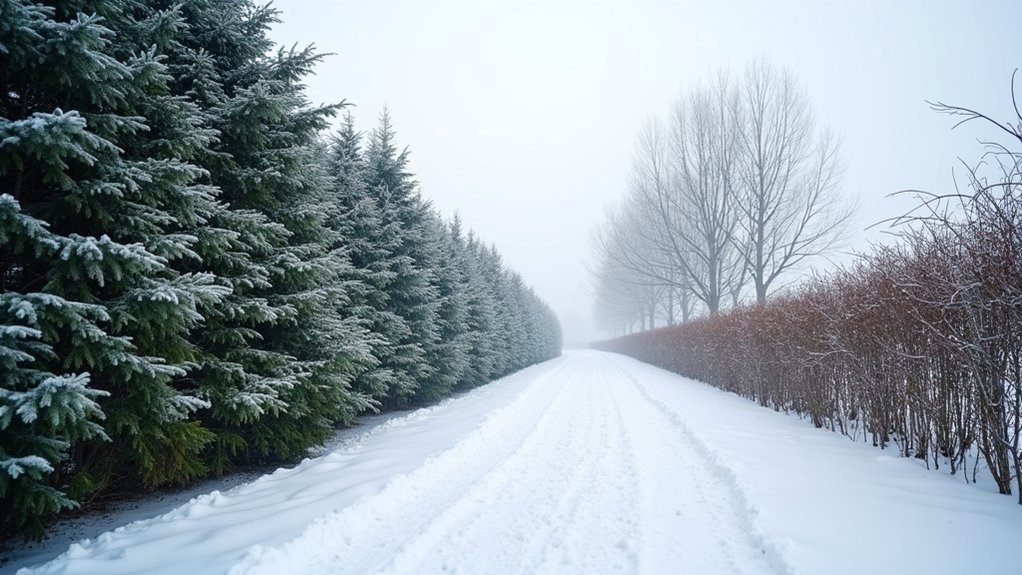
You’ll find evergreen hedges offer superior year-round wind protection in snowy regions, maintaining their dense 65% foliage barrier while deciduous varieties like beech provide only partial winter coverage.
When comparing snow-load tolerance, fast-growing options like Thuja ‘Green Giant’ excel at handling heavy accumulation without significant damage, though proper spacing remains essential for long-term health.
For ideal windbreak effectiveness, consider planting twin rows of evergreens on the prevailing wind side of your property, positioning them 100-150 feet from structures to create snow deposition zones that keep your walkways and driveways clearer.
Year-Round Protection Benefits
When designing hedges for snowy regions, understanding the year-round protection benefits of different varieties becomes essential for effective windbreak planning.
Evergreen hedges offer constant protection through winter months, functioning as both a privacy screen and winter windbreak with their dense, persistent foliage.
- Dense evergreen hedges reduce wind velocity by up to 85% when planted at ideal 65% density.
- Deciduous options allow winter sunlight penetration while still providing structural protection.
- Combined plantings create layered defense against snow drift and cold winds.
- Year-round hedges reduce heating costs by up to 30% in exposed properties.
- Strategic placement around buildings provides microclimate benefits even in harsh conditions.
You’ll find the most success by matching hedge types to your specific regional challenges, ensuring protection regardless of seasonal changes.
Snow-Load Tolerance Comparison
Although both evergreen and deciduous hedges serve as windbreaks, their ability to withstand heavy snow loads differs dramatically in winter conditions.
Evergreen hedges maintain superior structural integrity throughout snowy months, with their narrow, upright forms minimizing snow accumulation on branches.
For maximum snow-load tolerance, consider evergreens like Eastern White Pine, which feature flexible branches that bend rather than break under heavy snow.
In contrast, deciduous options like European Hornbeam become vulnerable when their broad, spreading branches catch and hold snow, increasing breakage risk.
While deciduous hedges lose their effectiveness when leaves drop, evergreen hedges continue providing reliable windbreak protection due to their persistent foliage.
For the best winter performance, you might combine both types—using evergreens as your primary snow defense while incorporating deciduous varieties for seasonal diversity.
Strategic Placement Tips
Properly positioned hedges can dramatically improve your property’s resilience against harsh winter conditions, with evergreens and deciduous varieties serving distinctly different roles in windbreak design.
When selecting trees for your protective hedge, consider these strategic placement tips:
- Evergreen conifers (pines, cedars, spruces) offer superior year-round protection while they provide privacy even in winter.
- Aim for 50-65% density in your windbreak hedge for peak effectiveness against snow drift.
- Plant conifer trees 20-25 feet apart to guarantee healthy growth and maximum wind resistance.
- Create staggered rows of trees rather than single lines to enhance your windbreak’s effectiveness.
- Supplement with deciduous shrubs like viburnum for seasonal diversity, recognizing they’ll provide less protection during winter months.
Top 10 Cold-Hardy Shrubs for Snow Region Hedges
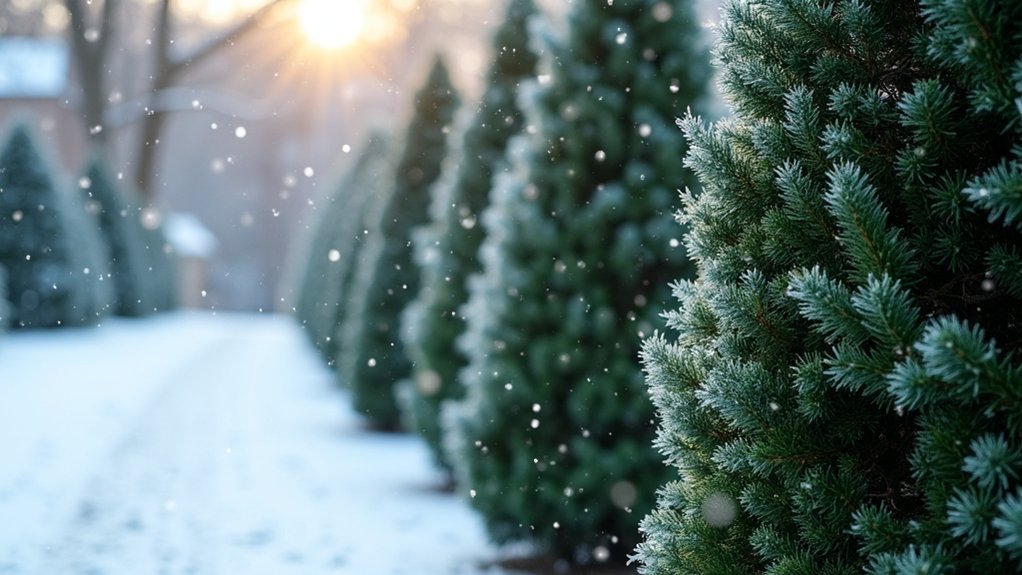
Creating resilient hedges in snow-prone areas requires selecting shrubs that can withstand harsh winters while maintaining their structure and appearance. American Arborvitae offers exceptional protection against cold winter winds, growing up to 2 feet annually with dense evergreen foliage that’s perfect for privacy hedges.
| Shrub | Benefits |
|---|---|
| American Arborvitae | Grows 2ft/year; dense windbreak |
| European Hornbeam | Resilient in zones 4-8; 12-24in growth |
| Boxwood | Low maintenance; dense coverage |
| Bald Cypress | Withstands wet/dry; 2-3ft/year |
| Viburnum | Dense growth; excellent lower protection |
For the most effective snow protection, consider combining these options—taller varieties like Arborvitae can block the strongest gusts, while shorter specimens like Boxwood provide essential ground-level coverage that prevents snow from drifting through your protective barrier.
Planning Your Hedge Layout for Optimal Wind Deflection
While beautiful landscapes remain a priority for many homeowners, strategic hedge placement serves as your primary defense against harsh winter winds in snowy regions.
Strategic hedges aren’t just decorative—they’re your home’s shield against winter’s icy assault.
When planning your windbreak, consider these essential design elements:
- Implement a staggered row design using both deciduous and evergreen shrubs to create maximum wind resistance.
- Aim for 50-65% windbreak density—dense enough to filter wind but not so solid that it creates turbulence.
- Space conifer trees 20-25 feet apart to maintain structural integrity while allowing proper growth.
- Plant lower-growing hedge plants 3-6 feet apart in the front row for a multi-tiered protection system.
- Select native, winter-hardy evergreen shrub varieties that will thrive in your local conditions while providing year-round protection.
Proper Spacing and Planting Techniques for Windbreak Hedges
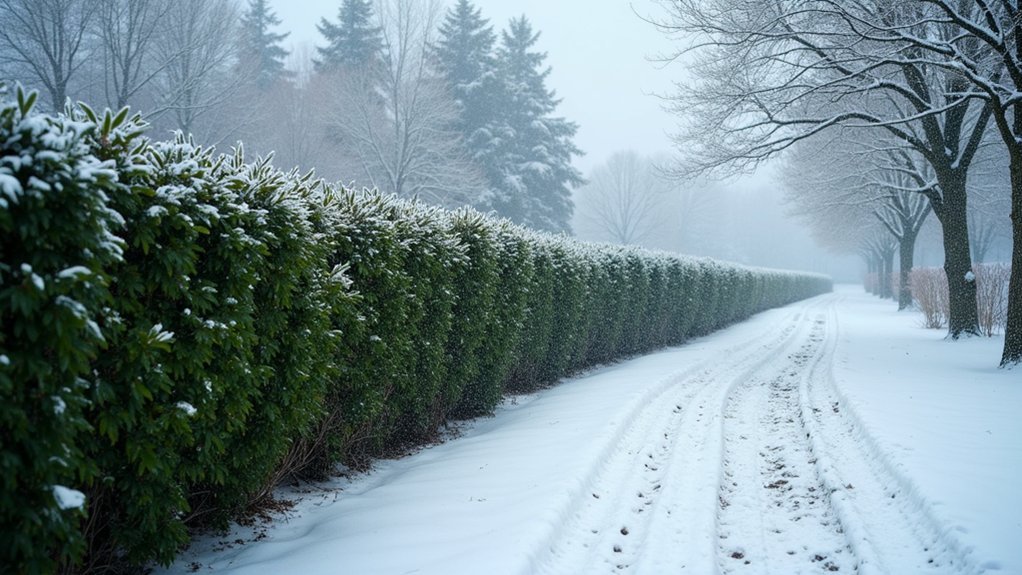
When establishing your windbreak hedge, you’ll need to take into account both windward and leeward gaps while maintaining proper spacing—3-6 feet for shrubs and 20-25 feet for conifers.
Your root ball positioning determines the long-term stability of the hedge, so make sure it sits at the proper depth with the root flare visible above soil level.
While trenching works well for continuous hedgerows, individual holes might serve you better when planting larger specimens or when working with varying soil conditions across your property.
Windward vs. Leeward Gaps
The strategic placement of gaps in your windbreak hedge can dramatically affect its performance throughout harsh winter months.
When designing your windbreak hedges, it’s essential to understand the difference between windward and leeward placements.
- Windward gaps should direct wind over the hedge rather than through it, effectively reducing wind speed.
- Leeward gaps improve air circulation and minimize snow accumulation.
- Combine deciduous and coniferous plants for maximum protection against harsh elements.
- Create staggered rows with denser plantings on the windward side to block most wind.
- Carefully manage gap positioning to avoid creating turbulence that undermines effectiveness.
Remember that proper spacing for planting is vital—place shrubs 3-6 feet apart within rows and 6-10 feet between rows, while trees need 12-20 feet depending on mature size.
Root Ball Positioning
Proper root ball positioning serves as the foundation for establishing resilient windbreak hedges that withstand harsh winter conditions.
When planting, guarantee root balls sit at the same depth they previously grew to prevent water pooling and promote healthy root development.
Space your trees and shrubs strategically: position shrubs 3-6 feet apart in single rows, while small trees require 10-15 feet between them.
For staggered arrangements, maintain 20-foot gaps between larger conifers to minimize resource competition.
Always consider mature width when determining spacing.
Plant slightly closer than the expected final width to accelerate the formation of a dense barrier.
Combining deciduous and coniferous species creates more effective windbreaks, but remember to account for their different growth rates and mature sizes in your initial layout.
Trench Vs. Individual Holes
Choosing between trench and individual hole planting methods greatly impacts your windbreak hedge’s long-term success in snowy regions.
The trench method creates a continuous root system and improves water retention, while individual holes give you better control over plant spacing and health.
For effective windbreaks in snowy climates, consider:
- Dig trenches at least 18 inches deep for proper root development
- Space shrubs 3-6 feet apart and small evergreen trees 10-15 feet apart
- Implement a staggered planting pattern to increase density and wind protection
- Aim for 50-65% density using two rows of evergreen trees and shrubs
- Select the trench method for continuous hedges and individual holes when precision spacing is essential
Either approach can work well if you maintain proper spacing and account for snow accumulation patterns.
Multi-Row Hedge Systems for Enhanced Protection
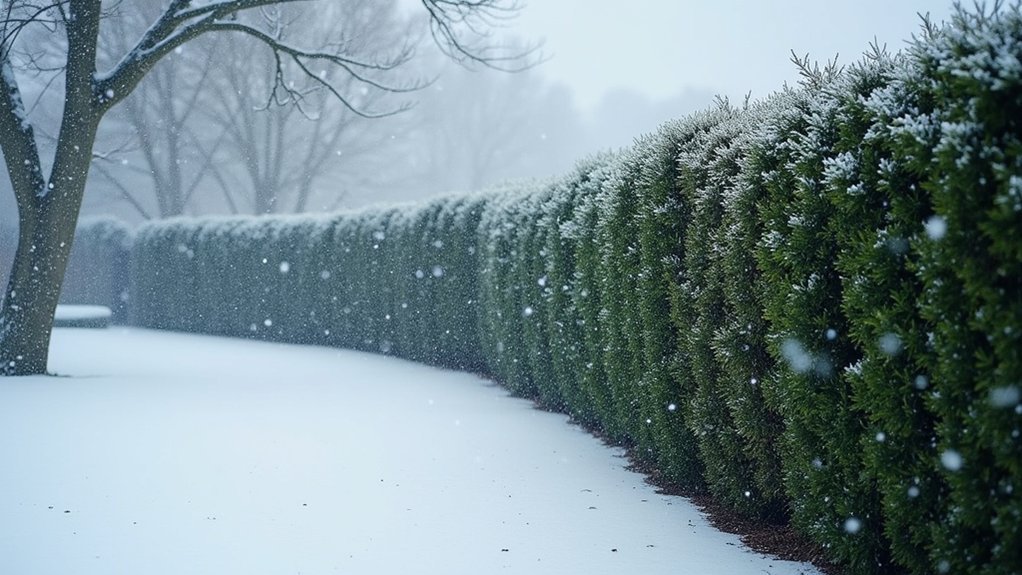
When harsh winter winds threaten your landscape, multi-row hedge systems provide superior protection by creating robust barriers that greatly reduce wind velocity and control snow accumulation.
Multi-row hedge systems create powerful barriers that tame fierce winter winds and manage snowdrift patterns effectively.
For ideal effectiveness, maintain a density of 50-65% by combining sturdy evergreen trees on outer rows with fast-growing deciduous species in inner rows.
Proper spacing is essential for your multi-row hedge system’s success. Plant small trees 10-15 feet apart within rows and allow 20 feet between rows to guarantee adequate growth and air circulation.
This strategic arrangement creates the dense barrier needed for maximum wind protection.
You’ll benefit from incorporating diverse species in your hedge system, which not only extends the windbreak’s lifespan but also strengthens its resilience against pests and diseases while promoting biodiversity in your snowy landscape.
Maintaining Your Windbreak Hedge During Winter Months
Winter’s fury demands vigilance even after you’ve established your multi-row hedge system. Your protective barrier needs special attention to withstand heavy snow loads and freezing temperatures.
To guarantee your windbreak thrives through winter:
- Prune any dead or damaged branches before the first snowfall to prevent breakage and promote healthy spring growth.
- Confirm proper watering in late fall so plants enter winter well-hydrated and stress-resistant.
- Apply mulch around hedge bases to protect roots from freezing and maintain soil moisture.
- Regularly inspect for damage after heavy snow or ice accumulation.
- Consider using burlap or specialized windbreak fabric for vulnerable sections facing harsh winds.
These simple maintenance practices will strengthen your hedge’s resilience, assuring it continues to shield your property through the harshest winter conditions.
How Windbreak Hedges Improve Energy Efficiency
As you face rising heating costs, windbreak hedges provide practical solutions for your snowy property. Dense evergreen hedges create a protective barrier that blocks harsh winter winds, reducing your heating demands and improving energy efficiency.
| Energy Efficiency Benefits | Impact |
|---|---|
| Reduced heating costs | Up to 30% savings |
| Wind speed reduction | Decreases by 50% |
| Snow accumulation | Minimized around structures |
| Heat retention | Prevents loss from buildings |
| Livestock facilities | Maintains comfortable environment |
Wildlife Benefits of Protective Hedge Barriers
Sturdy hedges planted around your property offer far more than just wind protection and energy savings.
Sturdy hedges transform your property into a protective haven while serving as vital natural sanctuaries.
They’re crucial sanctuaries for local wildlife, especially in harsh winter conditions. A well-established hedge provides privacy for you while creating essential habitats for numerous creatures.
- Dense foliage forms protective microclimates that shield small animals from extreme weather
- Hedgerows serve as wildlife corridors, allowing safe passage between larger habitats
- Berry-producing varieties offer a reliable food source when winter resources are scarce
- The structured environment supports diverse nesting sites for birds and small mammals
- Even in snow, hedges sustain pollinator populations by preserving hibernation spots
You’ll enjoy watching your hedge transform into a bustling ecosystem while it simultaneously protects your property from winter’s harsh elements.
Regional Considerations for Northern Climate Hedges
When planning hedges for northern regions, you’ll need to account for the unique challenges that extreme cold and heavy snowfall present. Selecting cold-hardy species is essential for survival through harsh winters.
Coniferous evergreens like Norway spruce and eastern white pine make excellent choices for windbreaks that persist year-round.
Plant your hedge with 50-65% density to effectively reduce wind speed while preventing excessive snow drifting. Space conifer trees 20-25 feet apart in rows to allow for proper growth and maximum protection.
Consider incorporating European Hornbeam alongside evergreens for seasonal variety without sacrificing functionality.
Whenever possible, prioritize native species that are naturally adapted to your local conditions. These plants will thrive with minimal intervention while supporting local wildlife and contributing to ecosystem sustainability in your northern landscape.
Economic Benefits of Living Windbreaks vs. Artificial Barriers
While many homeowners consider artificial barriers for winter protection, living windbreaks offer superior economic advantages that compound over time.
You’ll discover that these natural solutions deliver substantial returns on your investment beyond just winter protection.
- Living windbreaks reduce wind speed by up to 85%, far outperforming artificial alternatives.
- Initial installation and maintenance costs are lower, especially using existing plant material.
- Your soil health improves through reduced erosion and better moisture retention.
- Wildlife habitats created naturally support pollinators and enhance biodiversity.
- Your property value increases through improved aesthetics, privacy, and noise reduction.
These economic benefits make hedges a smart financial choice for your snowy property, delivering multiple returns while creating a resilient landscape that withstands harsh winter conditions year after year.
Frequently Asked Questions
What Is the Hardiest Hedge?
American Arborvitae (Thuja occidentalis) is your hardiest hedge option, thriving in zones 3-7. You’ll appreciate its ability to withstand harsh winter conditions while providing excellent structure and protection year-round.
What Is the Best Hedge to Stop Wind?
You’ll find dense evergreen conifers like pines, cedars, and junipers most effective at stopping wind. They maintain year-round foliage and create solid barriers. Plant them in staggered rows for maximum protection.
What Is the Fastest Growing Windbreak?
Thuja ‘Green Giant’ is your fastest windbreak option, growing 3-5 feet yearly. You’ll also get quick results with Leyland Cypress. Both will rapidly establish tall barriers that effectively block wind within a few seasons.
Can Hedges Survive Winter?
Yes, your hedges can survive winter. Many evergreens like Arborvitae and Boxwood offer natural insulation, while deciduous varieties like Beech adapt by shedding leaves. Proper planting and regular maintenance enhance their cold-weather resilience.
In Summary
You’ll find that sturdy hedges offer unparalleled protection against winter’s harsh elements while enhancing your property’s beauty and value. They’re not just barriers against snow and wind—they’re living investments that reduce energy costs, support local wildlife, and stand the test of time. By selecting the right species and placement for your climate, you’re creating a sustainable solution that outperforms artificial alternatives in every season.





Leave a Reply